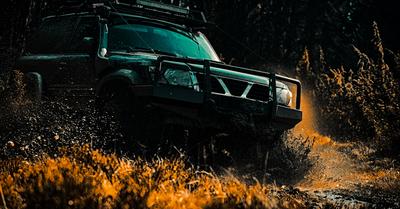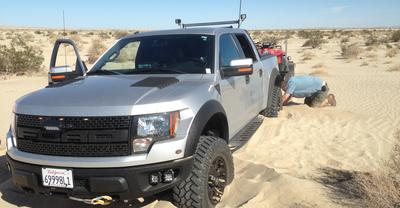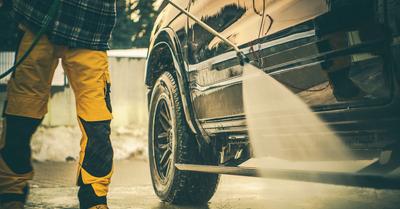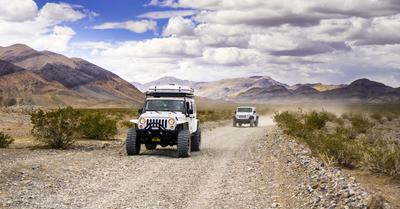Want to conquer the toughest off-road challenges? Discover the secrets to tuning your suspension for optimal performance. Read our expert guide today!
To tune the off-road suspension, adjust tire pressure for traction, set suspension sag by measuring and modifying preload, fine-tune rebound damping for comfort, and control return speed. Adjust compression damping for stability during impacts.
I've faced the same challenges you're dealing with. That's why I dedicated my time to researching and consulting experts in the field, gaining first-hand experience and valuable insights on off-road suspension tuning. I'm here to share my knowledge with you so we can conquer those trails together!
Key Takeaways
- Proper tire pressure is essential for optimal off-road traction and vehicle handling.
- Adjusting sag and preload is key to finding the perfect balance in your suspension.
- Fine-tuning rebound damping ensures comfort and control over the shock return speed.
- Optimizing high-speed compression damping to maintain stability during impacts.
- Drivers must adjust their style and practice to tune off-road suspension perfectly.
This article may contain affiliate links where we earn a commission from qualifying purchases.
How To Tune Off-Road Suspension
Tuning off-road suspension is crucial to optimizing a vehicle's performance on terrains. The process involves considering factors such as suspension geometry and the appropriate setup for your specific vehicle.
When properly tuned, a well-adjusted suspension system can absorb impacts, prevent poor handling, and provide a more exciting and comfortable off-road experience.
Various suspension systems are available for off-road enthusiasts, including three-link, four-link, radius arm, and triangulated link setups. Each design offers unique benefits and requires specific tuning techniques to maximize its potential.
Here’s how to tune off-road suspension;
Step 1: Determine Your Current Suspension Setup
Check your vehicle's owner's manual or consult a mechanic to determine what type of suspension your vehicle has and what adjustments can be made.
Step 2: Determine the Type of Terrain you Will be Driving on
Different terrains require different suspension setups. If you are unsure, start with a setup that is suitable for general off-road driving.
Step 3: Adjust Tire Pressure and Suspension Settings Based on the Terrain
Consult your owner's manual or a mechanic to determine the appropriate tire pressure and suspension settings for the terrain you will be driving on.
Step 4: Take Your Vehicle for a Test Drive and Listen for Feedback from the Suspension
Drive your vehicle on the terrain you plan to traverse and pay close attention to how it handles. Listen for any unusual sounds or vibrations, and feel for any changes in ride quality.
Step 5: Make Gradual Adjustments as Needed Based on the Feedback
Based on the feedback from your suspension, make gradual adjustments to your tire pressure and suspension settings. Start with small adjustments and test how they affect your vehicle's handling and ride quality.
Step 6: Repeat the Test Drive and Adjustment Process Until you Achieve the Desired Handling and Ride Quality
Continually test and adjust your suspension setup until you achieve the desired handling and ride quality for the terrain you are driving on.
Remember also to adjust your driving style and practice regularly to optimize the performance of your off-road suspension.
Tuning Basics
Tuning off-road suspension may seem overwhelming, but understanding the basics will make the process smoother.
Compression and Rebound
Adjusting compression and high-speed rebound settings to your needs is crucial for optimal performance and ride comfort. These settings help manage body roll and impact absorption, making your off-road experience safer and more enjoyable.
Valving and Damping
Valving and damping play a significant role in controlling the behavior of your off-road suspension system. Proper valving ensures that the suspension provides the right amount of resistance and support for various terrains and driving conditions, while damping helps control the overall motion of the suspension.
Damping can be adjusted using a bypass shock piston, which allows you to fine-tune compression and high-speed rebound setting.
Weight Distribution and Ride Quality
Proper weight transfer also helps manage body roll, which is the side-to-side motion of the vehicle when taking corners or navigating uneven terrain. Minimizing body roll is essential for maintaining control and stability while off-roading.
When tuning your off-road suspension, consider how balance and weight transfer, low-speed compression, low-speed rebound, and damping changes can affect ride quality differently.
Tuning for Specific Terrain
When tuning the off-road suspension, it's essential to consider the specific terrain you'll be driving on. The right setup can improve your vehicle's performance and comfort.
Smooth Terrains
The goal is to balance comfort and handling on smooth terrains, such as well-maintained dirt roads or flat grassy fields. Start by setting the pressure on your tire appropriately, as it significantly impacts vehicle harshness. It's better to begin with a soft baseline tune and adjust as needed.
Ideally, you'll want to maintain ample wheel travel to absorb small bumps and undulations effectively. Opt for low-speed compression adjustments and rebound settings on your bypass shocks, allowing them to react quickly to changes in terrain without unsettling the vehicle.
Rocky Terrain
For rocky terrain, suspension tuning should prioritize the wheels' ability to articulate and maintain contact with the ground. Increasing steering wheel travel and longer shock-tuning stroke lengths can improve traction and stability.
Hydraulic air bypass shocks with 2 to 4-inch stroke lengths can be particularly effective in such conditions. Slow down the rebound damping to allow the bypass shock absorber to extend further when traveling over rocks, providing more consistent contact with the ground.
Sandy Terrain
Sandy terrain, like desert dunes, presents unique challenges for off-road suspension tuning. Driving on sand requires maximizing flotation to prevent sinking or digging into the soft surface.
One way to achieve this is by using wider tires at lower pressures, which helps distribute the vehicle's weight over a larger contact patch. Adjust your shock-tuning settings accordingly, as lower tire pressures can affect your bypass shock absorber and the overall suspension performance.
In sandy conditions, the goal is to keep the vehicle from diving or pitching too much when accelerating or braking. To achieve this, you should increase the front suspension and rear suspension compression damping.
Since sand tends to be relatively forgiving, slightly softer shock-tuning settings can provide adequate control and comfort during high-speed compression runs or jump.
Advanced Off-Road Suspension Tuning
When optimizing the suspension of an off-road vehicle, several factors need to be considered to ensure a high-performance driving experience.
Sway Bars and Chassis Control
Sway bars are essential in maintaining a vehicle's stability during hard off-road driving by controlling the chassis roll during cornering. They connect the left and right sides of a vehicle's suspension, distributing forces during turns and helping maintain shock body roll or tire wear to a minimum.
To fine-tune the effect of a sway bar on chassis control, stiffer bars can be installed to reduce shock body roll, while softer bars will allow for more suspension articulation. Adjusting the length and mounting points of the sway bar can also help tailor their performance to suit better the off-road driving conditions the vehicle will encounter.
Air Bumps and Bottoming Out Prevention
Air pressure bumps or hydraulic bump stops are essential components preventing tire wear during fast off-road driving for positive camber. They act as progressive springs that absorb the impact of hard suspension compression shin and protect the vehicle from damage.
Tuning air bump pressure according to the vehicle's corner sprung weight can enhance performance and comfortable ride height. To determine the correct air bump pressure, start with one-sixth of the corner sprung weight as a baseline.
Suspension Setup for High Performance
For optimal off-road performance, the best suspension components, like spring rate, negative camber, dampers, and geometry settings, need precise tuning to suit specific driving track conditions.
Begin by setting the pressure on your tire to your desired level for an off-road driving style. Ensure your suspension components are in good condition and properly maintained. Adjust the suspension geometry and ride height to suit the terrain and vehicle specifications.
Quality adjustable components like king shocks and a spring rate can significantly affect off-road performance.
Dual Rate Stops and Flutter Stack
Dual rate stops, often used in coilover suspension setups, change the spring rate and progressively stiffen the spring under high-speed compression. This allows for a plush ride height during normal off-road driving while providing adequate support when the suspension is compressed aggressively.
Flutter stacks are thin, tapered shims placed inside a bypass shock piston absorber to alter the damping force. Adjusting the thickness, quantity, and arrangement of the rebound shim stacks makes it possible to fine-tune the damping force for specific off-road driving conditions and improve ride quality.
Heavier or aggressive off-road driving might require stiffer springs, dual-rate stops, or more progressive flutter stacks to maintain consistent performance and comfort.
How the Role of the Driver Relates to Tuning Off-road Suspension
Your Driving Style Matters
When it comes to off-roading, your driving style can significantly impact how your vehicle handles and performs. This is especially true when it comes to suspension tuning. An experienced driver who knows how to read the terrain and adjust their driving style accordingly will be better able to fine-tune their suspension system to meet the demands of the terrain.
Know Your Vehicle's Capabilities
Before you can start tuning your off-road suspension, it's important to have a good understanding of what your vehicle is capable of. Different vehicles will have different suspension setups and tuning requirements, so it's important to know what you're working with before you start making adjustments.
Get Feedback From Your Suspension
One of the keys to tuning your off-road suspension is paying close attention to how it performs as you drive. Listen for any unusual sounds or vibrations, and feel for any changes in the vehicle's handling or ride quality. This feedback can help you identify areas where the suspension might need to be adjusted.
Adjust Gradually
When tuning your off-road suspension, it's important to gradually and methodically adjust. Start with small adjustments and test how they affect the vehicle's handling and ride quality before making more significant changes. This will help you fine-tune your suspension system without inadvertently introducing new problems.
Practice, Practice, Practice
Finally, the best way to develop your skills as an off-road driver and suspension tuner is through practice. Take your vehicle out on a variety of terrains and experiment with different suspension settings. Over time, you'll better understand how your vehicle handles and what adjustments are needed to optimize its performance.
While tuning off-road suspension requires some technical knowledge and skill, it's also an art form that requires a certain level of intuition and experience. By understanding the relationship between your driving style, your vehicle's capabilities, and your suspension system, and by taking a gradual and methodical approach to adjustments, you can fine-tune your off-road suspension to meet the demands of any terrain.
Common Off-Road Suspension Tuning Mistakes to Avoid
When tuning the off-road suspension, it's crucial to avoid common mistakes that can negatively impact your vehicle's performance.
Running Too Much Low-Speed Rebound Damping
One common mistake is running too much low-speed rebound damping. Although it can provide better cornering control, excessive rebound damping may cause a harsh ride and hinder suspension droop in rough terrain. A better approach is to use a sway bar and fine-tune the bypass shocks for optimal ride quality.
Improperly Installing Forks
Many off-roaders make the mistake of improperly installing their forks. Ensuring that your fork tubes aren't in a bind is essential for a well-functioning suspension design system. Follow the manufacturer's guidelines and pay close attention to the installation process.
Realigning the Components
Modifying your suspension can throw your vehicle's alignment out of whack. Avoid potential damage by re-aligning the components after any suspension adjustments. This will ensure that your vehicle maintains its handling and dumping characteristics and reduces the risk of uneven front tire wear or other issues to toe out problems.
Relying Too Much on Lift Blocks
Another typical error is relying too much on lift blocks for rear-toe spring suspension. Although they can be affordable for raising your vehicle, they aren't highly recommended due to potential stability concerns. Exploring other suspension lift options like new leaf springs or aftermarket suspension systems is best.
Finding the Right Suspension Balance
When adjusting the low-speed compression and high-speed rebound damping of dirt bike suspension, finding the right balance between preventing bottoming out and maintaining traction is essential. A low-speed and high-speed compression stack needs to be carefully adjusted so the bike performs well on various terrains.
Picking the Ideal Suspension Setup
Selecting the right suspension setup for your ride is crucial for off-road performance. The right suspension setup is more important than having the perfect set of tires. Research your options, consult with experts, and invest in a well-suited system for your specific off-roading needs.
By being aware of these common off-road suspension tuning mistakes, you can make the necessary adjustments to optimize your vehicle's performance and ensure a smooth, enjoyable off-road experience. Remember that proper installation, negative camber angle, alignment, and damping adjustments are key elements in maintaining excellent off-road handling and control.









